#transverse arch
Text


Plant of the Day
Wednesday 14 February 2024
Even after the storms and snow of winter this Asplenium scolopendrium (hart's tongue fern, burnt weed, buttonhole) growing in the shelter of a wall still provides a great display. There is a rosette of arching, evergreen, strap-shaped fronds. The margins are frequently undulated with the spores in conspicuous transverse stripes beneath the fronds.
Jill Raggett
#Asplenium#hart's tongue fern#burnt weed#buttonhole#plants#fern#fronds#horticulture#gardens#garden#Marengo Garden#orkney
59 notes
·
View notes
Note
I don’t want to be a lawyer but I love debate and watching the moots mock court. Any tips on how to be transversed in communication and confident speech like lawyers when they prep? Thank you!
Thoroughly review and research
Deep dive into all of the facts and plot points/characters & timelines of your "case"/argument
Create a logical story arch based on fact, statistics, reason, and common sense with enough evidence to dispel the counterargument (the "defense")
Refine your argument to engage in compelling, convincing storytelling using words, factual-based arguments/interpretations, personal anecdotes, visuals, videos, etc.
Hope this helps xx
#persuasive#communication skills#purposively communicating#people skills#conversational intelligence#influence and persuasion#debate#writing skills#life skills#social skills#leadership skills#assertivecommunication#femmefatalevibe#q/a
43 notes
·
View notes
Text

The Christmas Comet 46P/
Wirtanen photographed as it transverses the sky the night of
12 December 2018 in Bleikvassli, Norway (Photo credit: Tommy Eliassen)
* * * * *
Nativity
by Li-Young Lee
In the dark, a child might ask, What is the world?
just to hear his sister
promise, An unfinished wing of heaven,
just to hear his brother say,
A house inside a house,
but most of all to hear his mother answer,
One more song, then you go to sleep.
How could anyone in that bed guess
the question finds its beginning
in the answer long growing
inside the one who asked, that restless boy,
the night's darling?
Later, a man lying awake,
he might ask it again,
just to hear the silence
charge him, This night
arching over your sleepless wondering,
this night, the near ground
every reaching-out-to overreaches,
just to remind himself
out of what little earth and duration,
out of what immense good-bye,
each must make a safe place of his heart,
before so strange and wild a guest
as God approaches.
[alive on all channels]
14 notes
·
View notes
Photo



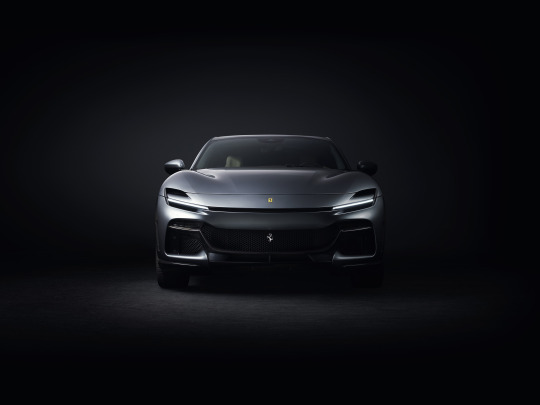
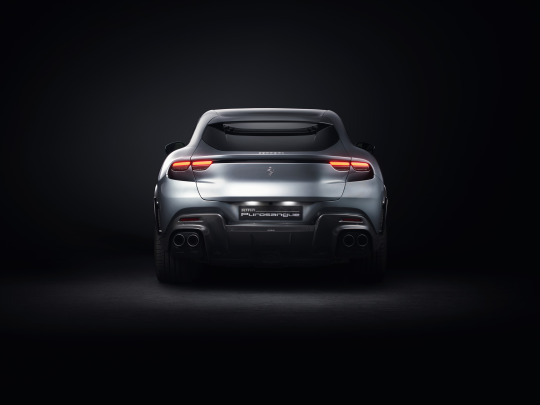
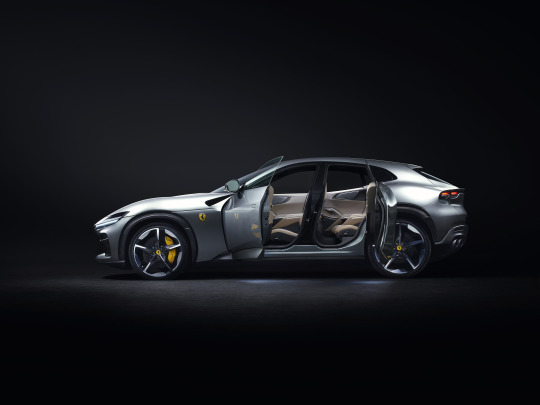

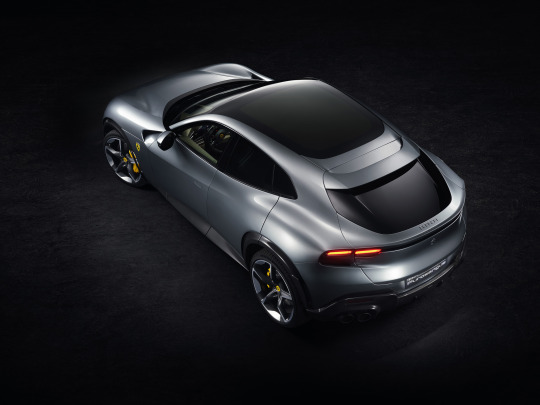
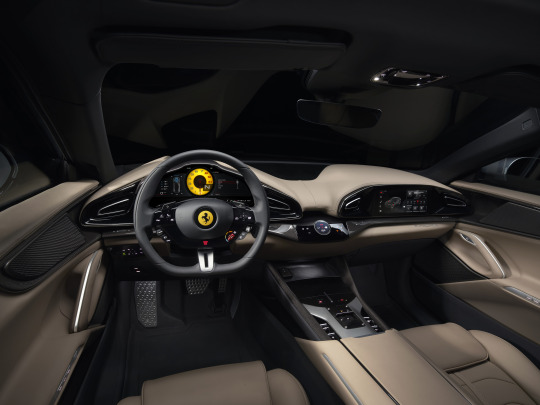
First Look: The Ferrari Purosangue
After years of anticipation by the international automotive fraternity, Ferrari has unveiled the Purosangue, the first ever four-door, four-seater car in the Prancing Horse’s 75-year history.
Since the marque’s earliest years, 2+2 cars (i.e. with two front and two smaller back seats) have played a significant role in its strategy. Many Ferraris have made combining benchmark performance with first class comfort one of the pillars of their success. Now, in the culmination of 75 years of leading-edge research, Ferrari has created a car that is unique on the world stage: not only do performance, driving pleasure and comfort coexist in perfect harmony, but it is also a peerless encapsulation of the Prancing Horse’s iconic DNA. This is the reason why the name Purosangue, Italian for ‘thoroughbred’, was chosen.
To enable the company to achieve the ambitious goals set for this project and create a car worthy of a place in its range, a completely different layout and innovative proportions compared to modern GT archetypes (so-called crossovers and SUVs) were adopted. The average modern GT’s engine is mounted forwards in the car, almost straddling the front axle with the gearbox coupled directly to it; this results in less than optimal weight distribution that delivers driving dynamics and driving pleasure well short of the standards of excellence to which Prancing Horse clients and enthusiasts have become accustomed.
The Purosangue, on the other hand, has a mid-front-mounted engine with the gearbox at the rear to create a sporty transaxle layout. The Power Transfer Unit (PTU) is coupled in front of the engine to provide a unique 4×4 transmission. This delivers exactly the 49:51% weight distribution that Maranello’s engineers deem optimal for a mid-front-engined sports car.
The Purosangue stands head and shoulders above the rest of the market thanks to its performance and comfort. It is the only car with these proportions to sport a mid-front-mounted, naturally-aspirated V12. Maranello’s most iconic engine debuts in this brand new configuration to ensure the car unleashes more power than any other in the segment (725 cv) whilst guaranteeing the most enthralling Ferrari engine soundtrack. Furthermore, it can deliver 80% torque even at low revs for unique driving pleasure at all times.
The Purosangue’s aero development focused on making the bodywork, underbody and rear diffuser as efficient as possible. New solutions include synergy between the front bumper and wheel arch trim which generates an air curtain that aerodynamically seals the front wheels, preventing turbulent transverse air flows being generated.
Ferrari has also given the Purosangue the very latest iterations of the vehicle dynamic control systems introduced on its most powerful and exclusive sports cars, including independent four-wheel steering and ABS ‘evo’ with the 6-way Chassis Dynamic Sensor (6w-CDS). Making its world debut is the new Ferrari active suspension system. This very effectively controls body roll in corners as well as the tyre contact patch over high-frequency bumps to deliver the same performance and handling response as in one of the marque’s sports cars.
The all-new chassis has a carbon-fibre roof as standard to keep weight down and lower the centre of gravity. Redesigning the bodyshell from scratch also meant the designers could incorporate rear-hinged back doors (welcome doors) to make ingress and egress easier while keeping the car as compact as possible. The cabin has four generous heated electric seats that will comfortably accommodate four adults. The boot is the largest ever seen on a Ferrari and the rear seats fold to increase the luggage space. Naturally enough, the Purosangue has a more commanding driving position than other Ferraris, but the configuration is the same as on every other Ferrari. As a result, the driving position is still intimate and close to the floor to provide greater connection to the car’s dynamic capabilities.
The Purosangue offers class-leading performance figures (from 0 to 100 km/h in 3.3 s and from 0 to 200 in 10.6 s); the driving position and the heady, naturally-aspirated V12 soundtrack deliver an entirely new yet also entirely Ferrari driving experience. The fact that a vast array of comfort-focused content is provided as standard, such as the Burmester© audio system, and that the many optional extras including the brand-new Alcantara® upholstery, derived from certified recycled polyester, make the Purosangue the most complete four-door, four-seater in the segment.
192 notes
·
View notes
Text
A few panicked thoughts on writing the anatomy essay on tiefling tails. Don't worry about it, nothing earthshattering and new in here, just my own musings and fears.
Gods, I loved the hbomberguy video on plagiarism, but as someone who already had imposter syndrome before, writing the essay on tiefling tails now makes me feel even more stressed. Like, I'll go "crap, what was that bone called again?" and look it up and then put the name in there and be like "...do I have to cite a source for this?? Have I plagiarized? Is it bad that my source for that bone name is wikipedia because it was the first thing that popped up??"
Since my bachelor's degree required fairly little formal writing considering it's in computer science and nobody there is a very good writer, I just slapped all the sources in there with footnotes and then later on had a source page or six. And my diploma also didn't have me write an academic paper considering the exams in the end were mostly practical and also in German, so what I did write was at least in my native language.
I initially wanted this whole essay to be just a quick little overview, perhaps with 1 or 2 drawings, but it spiraled out of control and I'm happy with how much I found out so far, but now I'm scared in a very strange way. It's not even like I'm trying to write something academic, because what I'm aiming for is a comprehensive overview that anyone should be able to understand, or at least draw conclusions from without getting overwhelmed or having to look up medical texts.
Like if my source says "The outermost part of the skin is the epidermis", which is a well-known fact and taught in lots of biology classes around the world, and I write "1. Epidermis (outermost layer of skin)", do I need to cite a source? Do I need to find a way to rephrase it??
If the source ("A Laboratory Manual for Comparative Vertebrate Anatomy") says "Neural arches, transverse processes, and zygapophyses diminish caudally, the last vertebrae consisting of centra only", and I write "Tails in vertebrates are generally made up of up to fifty caudal vertebrae (tail vertebrae, meaning the bones that make up the tail itself) that towards the tip of the tail decrease in arches (the indentations on the sides of the vertebra), as well as transverse and articular processes (the projections on the sides of the vertebra) towards the tip, meaning the bones become smoother with shorter protrusions the longer the tail is and the more vertebrae are found within an individual's tail." did I add anything new? Did I plagiarize the sentence? Did I add value along the way that makes it okay? (I will be adding an illustration to show this as well, to make it less difficult to understand.)
I'm genuinely unsure on how to do this. I'll stil do my best to keep writing, but my constant fear of messing up has increased tenfolds now.
I'm not trying to research anything or show anything completely groundbreaking and new, this isn't me trying to invent a new species and then trying to bioengineer it into existence. I'm just trying to help others understand how things could work in a fantasy setting. But I still don't want to mess this up, I want to create something that I can be proud of, not something that steals from others without adding any value, even though in the end it will mostly be a collection of information more than anything else.
I know he kept saying that plagiarism is always intentional and you can't accidentally plagiarize anything, but I just don't know where the line is between "I'm compiling information from lots and lots of thoughts and combining it to fit what I'm trying to explain" and "I'm taking information from lots of sources and making it look like I am an expert on all of those things when I'm not."
I just have...a lot of thoughts.
1 note
·
View note
Photo

This week's #MS1 post is about the #anatomy of the parotid glands, a pair of salivary glands located in front and below the ears, over the angle of the jaw. A number of structures pass through them:
- cranial nerve VII (facial n.)
- retromandibular vein
- external carotid artery
- superficial temporal artery
- great auricular nerve branches
- maxillary artery
Figure III 1. Supra-orbital foramen 2. Infra-orbital foramen 3. Mental foramen 4. Zygomatic arch 5. Parotid gland 6. Transverse facial artery 7. Stensen's duct 8. Facial nerve 9. Common carotid artery 10. External carotid artery 11. Internal carotid artery 15 Internal jugular vein 16. External jugular vein
Source Louis Bathe Rawling, Landmarks and Surface Markings of the Human Body (1913), p. 41. Courtesy Internal Archive.
2 notes
·
View notes
Text
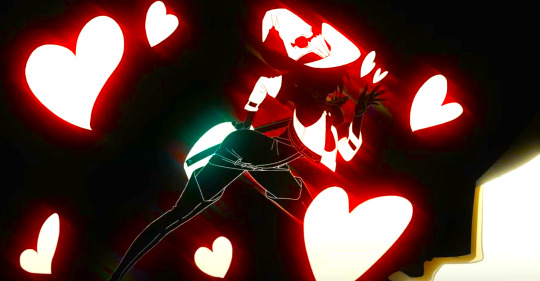
I-No || Guilty Gear
♫ Time Traveling Heavy Metal Witch causes problems on purpose
♫ A sadistic, cold hearted, egotistical bitch who also happens to be the manifestation of mankind's desire for a "brighter tomorrow" put in the body of a regular human. It's kinda complicated, babe.
♫ Basically a badguy who is forced to be a goodguy by cosmic design
♫ The guitar's name is Marlene ♥
♫ Queen of innuendoes, especially of the musical and sexual variety.
♫ Horny as all hell. Will flirt with you as long as you're of age.
♫ Extremely under stimulated and disassociated from the rest of humanity after transversing and manipulating the timeline for so long. Believe it or not she started off a decent person.
♫ [Bleep] you, you [bleep]! I hope you [bleep] [bleep] [bleep]
♫ Recently had an existential crisis and quit her boss that she didn't really listen to anyway. Became God for a hot minute. Died on the inside before dying literally to her Freddy Mercury Fanboy arch nemesis.
♫ Remembered herself in her final moments. Well-maybe not her final moments anymore. She IS here in Isola after all. Sucks for you losers, huh?
0 notes
Text
This is How Your Shoes Act as a Catalyst in Shaping Your Feet Right
Feet support our overall body as they take the weight of us every step of life. For men finding a perfect pair of shoes becomes more important as they indulge in more physical activities. The right pair of shoes not only highlight your look for the day or night but also support your posture, foot health, and overall walk. We have written this blog to tell the importance of wearing the right shoe and how it can help your overall foot health. You can buy the most comfortable men's casual shoes online to provide support to your feet.

5 Benefits of Wearing Right Shoes
1. Arch Support and Stability:
The key function of a shoe is to provide arch support and stability to your feet. It is important to shape your feet by supporting the longitudinal arch and transverse arch and only the right pair of shoes can do that for your health. Running along or running across, your feet need to feel properly held for comfort. If your shoes do not have proper arch support, it can give you flat feet or fallen arches. A right shoe will prevent overpronation or supination.
2. Toe Box Space:
The toe space of a shoe should be comfortable as it needs breathing space too for foot health. Narrow-sided shoes can give you bunions, corns, and ingrown toenails. A spacious toe box will help free the flow of the feet, allow proper alignment, remove the risk of deformities, and enhance overall foot comfort.
3. Proper Sizing:
The fundamental rule of buying the right shoe is to get the proper size. Ill-fitted shoes, either tight or loose can cause various issues such as blisters, calluses, and even deformities. It can cause leg pain or even ruin your posture affecting your overall foot health.
4. Material Matters:
The material of the shoes needs to be breathable. It is important to buy shoes that regulate temperature and remove fungal infections. Quality material is important to contribute to the durability of the shoe. Natural materials like leather help prevent moisture and athlete’s foot.
5. Activity-Specific Footwear:
It is important to consider the purpose of the shoe whether you will be using it for running, hiking, casual wear, or party night. Wearing activity-based shoes will allow free flow during various physical activities and help your feet. You can buy men's casual shoes at low prices online to support your feet.
In the grand scheme of overall health, we often overlook the importance of our feet. Investing time and consideration into selecting the right footwear can have a profound impact on the development and well-being of your feet. From arch support to toe box space, proper sizing to material choices, your shoes act as a catalyst in shaping your feet right. So, step into wellness by choosing shoes that prioritize both style and foot health, ensuring a solid foundation for a lifetime of comfortable mobility.
#affordable online shopping sites in india#trendy online shopping sites in india#men's running sneakers on sale
0 notes
Link
Check out this listing I just added to my Poshmark closet: EUC✨Madrid EVA Rose.
0 notes
Text
The panel reproduces the transversal section, stylized, of the Mosque of the Prophet in Medina. Below the upper tier, a central cuspid arch and two lateral arches supported by four elegant spiral columns, crowned by a crescent. Three mosque lamps are suspended in correspondence with the centre of the arches' vaul. In the middle, a central scroll displays the inscription "Glory to Allah".
Nine-tiled panel
17th century AD
Syria
11th century
Tiles, panel, architectonic decoration
Ottoman
w84 x h84 cm
Ceramic
Direitos: All Rights Reserved - MAO - Museo d'Arte Orientale, Turin
#edisonmariotti
.br
O painel reproduz o corte transversal, estilizado, da Mesquita do Profeta em Medina. Abaixo da camada superior, um arco cúspide central e dois arcos laterais sustentados por quatro elegantes colunas espirais, coroadas por uma meia-lua. Três lâmpadas da mesquita estão suspensas em correspondência com o centro da abóbada dos arcos. No meio, um pergaminho central exibe a inscrição "Glória a Allah".
Painel de nove azulejos
Século 17 DC
Síria
século 11
Azulejos, painéis, decoração arquitetônica
otomano
L84 x A84 cm
Cerâmica
Direitos: Todos os Direitos Reservados - MAO - Museo d'Arte Orientale, Torino
@edisonblog
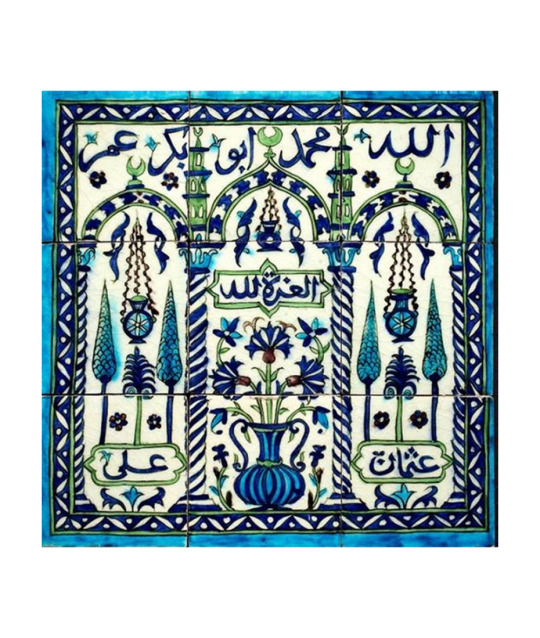
0 notes
Text
Unraveling the Mystery: Understanding and Alleviating Pain Under the Foot Arch
The human foot is a complex marvel of biomechanics, supporting our entire body weight and facilitating movement. Yet, even in this intricately designed structure, pain can emerge, disrupting our daily lives and activities. One common area of discomfort is under the foot arch, a region critical for weight distribution and shock absorption. In this article, we will explore the various causes of pain under the foot arch, delve into potential solutions, and gain insights from The Footwork Clinic, an institution at the forefront of addressing foot-related issues.
I. The Foot Arch: A Crucial Support Structure:
Understanding the Anatomy: The foot arch is formed by the tarsal and metatarsal bones, connected by tendons and ligaments. This architectural marvel acts as a natural shock absorber, distributing the forces exerted during walking, running, and standing. The arch comprises three main components: the medial (inner) arch, lateral (outer) arch, and transverse (across the foot) arch.
Importance of Arch Functionality: The proper functioning of the foot arch is vital for maintaining balance, stability, and efficient movement. When the arch is compromised, whether due to injury, strain, or underlying conditions, it can lead to pain and discomfort.
II. Causes of Pain Under the Foot Arch:
Plantar Fasciitis: Plantar fasciitis is a common culprit for arch pain. It involves inflammation of the plantar fascia, a band of tissue connecting the heel to the toes. The condition is often characterized by sharp pain under the heel or arch, especially during the first steps in the morning.
Flat Feet (Pes Planus): Flat feet occur when the arches collapse, causing the entire sole of the foot to make contact with the ground. This can lead to strain and discomfort under the arch, particularly during weight-bearing activities.
Overpronation: Overpronation is an abnormal inward rolling of the foot during walking or running. This motion can stress the arch and lead to pain. Individuals with flat feet are more prone to overpronation.
High Arches (Pes Cavus): Conversely, high arches can also contribute to pain. The elevated arches may not provide adequate shock absorption, resulting in increased pressure on certain areas of the foot.
Tendonitis: Inflammation of the tendons that support the arch can cause pain. This may be a result of overuse, improper footwear, or biomechanical issues.
Stress Fractures: Stress fractures, often caused by repetitive stress on the foot, can lead to arch pain. Athletes and individuals engaged in high-impact activities may be particularly susceptible.
III. Seeking Relief: Traditional and Innovative Approaches
R.I.C.E Protocol: The conventional Rest, Ice, Compression, and Elevation (R.I.C.E) protocol can provide initial relief for arch pain. Resting the foot, applying ice to reduce inflammation, using compression wraps, and elevating the foot can alleviate acute discomfort.
Footwear Modification: Choosing appropriate footwear is crucial for managing arch pain. Supportive shoes with proper arch support can help distribute pressure evenly and reduce strain. The Footwork Clinic emphasizes the significance of customized orthotic insoles to address specific foot biomechanics and provide optimal support.
Physical Therapy: Physical therapy exercises can strengthen the muscles supporting the foot arch and improve flexibility. A tailored exercise regimen, prescribed by a physical therapist, can contribute to long-term relief.
Stretching and Strengthening Exercises: The Footwork Clinic recommends specific stretching and strengthening exercises to enhance the flexibility and stability of the foot arch. These exercises aim to address underlying issues contributing to pain and prevent recurrence.
Shockwave Therapy: In cases of chronic arch pain, shockwave therapy may be considered. This non-invasive treatment involves the application of acoustic waves to stimulate healing and reduce inflammation. The Footwork Clinic may incorporate shockwave therapy as part of a comprehensive approach to address persistent arch pain.
IV. The Footwork Clinic: Leaders in Foot Health and Rehabilitation
Holistic Approach to Foot Health: The Footwork Clinic stands out as a beacon of expertise in foot health and rehabilitation. With a holistic approach, the clinic addresses not only the symptoms but also the root causes of foot-related issues, including pain under the foot arch.
Comprehensive Assessment: A thorough assessment is the foundation of The Footwork Clinic's approach. The team, comprising experienced podiatrists and specialists, conducts a detailed examination to understand the individual's biomechanics, gait, and overall foot health.
Custom Orthotic Solutions: The Footwork Clinic is renowned for its commitment to personalized care. The clinic offers custom orthotic solutions tailored to the unique needs of each patient. These orthotics play a pivotal role in supporting the foot arch and addressing underlying issues contributing to pain.
Cutting-Edge Technologies: Leveraging cutting-edge technologies, The Footwork Clinic incorporates innovative treatments such as shockwave therapy to enhance the efficacy of their rehabilitation programs. This commitment to staying at the forefront of podiatric care sets the clinic apart.
Patient Education and Empowerment: Education is a cornerstone of The Footwork Clinic's approach. Patients are not only treated for their immediate concerns but are also empowered with knowledge about foot health, preventive measures, and ongoing self-care.
V. Lifestyle Considerations and Preventive Measures:
Maintaining a Healthy Weight: Excess body weight can exacerbate arch pain. Maintaining a healthy weight through proper diet and regular exercise can reduce the strain on the foot arch.
Proper Warm-up and Cool-down: Engaging in appropriate warm-up and cool-down activities before and after physical exercise can help prepare the muscles and prevent injuries that may contribute to arch pain.
Choosing the Right Footwear: Wearing shoes with proper arch support and cushioning is essential. The Footwork Clinic emphasizes the importance of selecting footwear that complements individual foot biomechanics and activities.
Regular Foot Checks: Regular self-checks of the feet for any signs of discomfort, swelling, or changes in appearance can help identify issues early. Seeking prompt attention for any abnormalities is crucial for preventive care.
VI. Future Trends in Foot Health:
Advancements in Orthotic Technology: The field of orthotics continues to evolve, with ongoing advancements in technology. Future trends may include the development of more sophisticated and personalized orthotic solutions, leveraging materials and designs for optimal support and comfort.
Integration of Telehealth Services: The integration of telehealth services is a growing trend in healthcare. The Footwork Clinic may explore telehealth options for initial consultations, follow-ups, and educational sessions, making foot health more accessible to a wider audience.
Conclusion:
Pain under the foot arch is a common ailment that can significantly impact daily life. Understanding the causes, seeking timely intervention, and adopting preventive measures are crucial steps towards alleviating discomfort and maintaining optimal foot health. The Footwork Clinic, with its commitment to excellence, personalized care, and innovative solutions, stands as a beacon of hope for individuals seeking relief from foot-related issues. As we navigate the dynamic landscape of healthcare, the insights and expertise provided by institutions like The Footwork Clinic pave the way for a future where foot health is prioritized, understood, and effectively addressed.
0 notes
Text
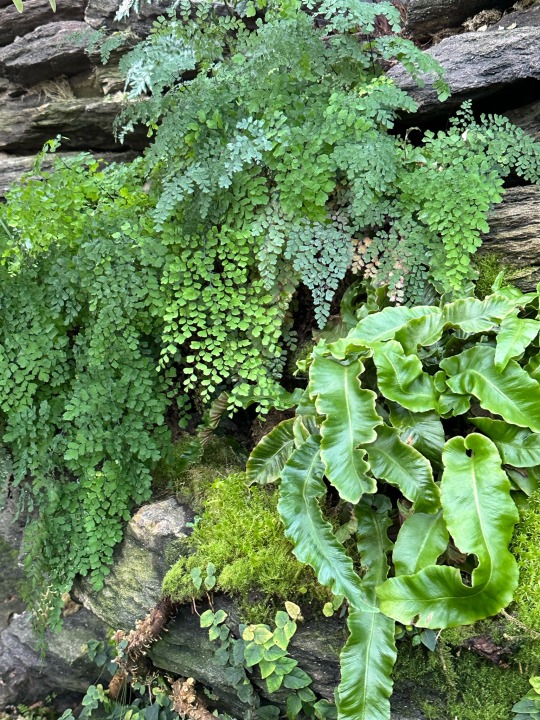

Plant of the Day
Wednesday 15 February 2023
The hardy Phyllitis scolopendrium (Asplenium fern, hart's tongue fern, horse tongue) has been included in this glasshouse fernery. This evergreen fern forms a rosette of arching, strap-shaped fronds with margins that often undulate. Spores are borne in transverse stripes beneath the fronds.
Jill Raggett
#phyllitis#asplenium#hart'stonguefern#horsetongue#fern#plants#gardens#horticulture#writtledesign#glasshousedisplay#inverness
141 notes
·
View notes
Link
Check out this listing I just added to my Poshmark closet: Pearl Izumi Select Road V5 Studio Cycling Shoes EUR 52.
0 notes
Text
Romanesque Architecture Terms
Barrel Vault: A vault forming a half cylinder, held up by butresses.
Groin Vault: Primarily on aisles, two barrel vaults intersected perpendicularly. The focused pressure allows for less buttressing.
Lantern: Dome with windows to let light in typically above the apse.
Transverse Arch: Supporting arch which runs across the vault, dividing space into geometrical volumes.
Pier: Support that sustains vertical pressure.
Compound Pier: Multiple columns combined to divert pressure.
Engaged Column: Weight bearing column embedded in wall.
Pilasters: Not weight bearing, decorative, draws eyes up, embedded in the wall.
Metalwork Techniques:
Filigree: gold in long strips or balls as decoration.
Inlaid: Gems or stones that stick out.
Repousse: Designs carved into wood, gold put over.
Niello: 2 metals to create a pattern.
Champlevé: Gold or other metal gouged out and enamel put into décor.
Cloisonné: Compartments with metal, put enamel inside and fire.
1 note
·
View note
Photo


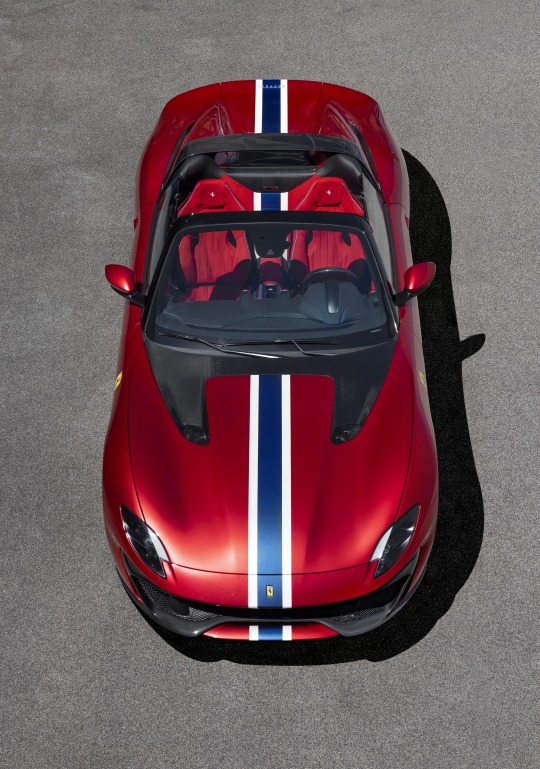

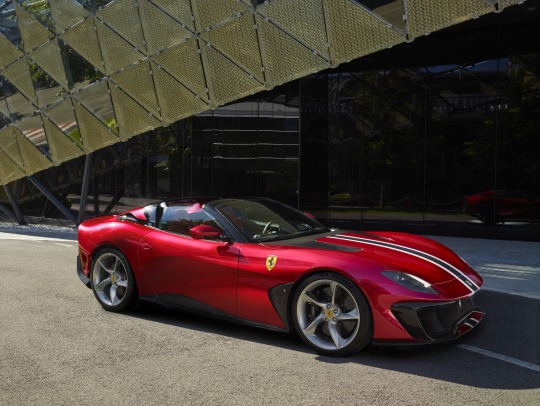


First Look: The 812 GTS-Inspired Ferrari SP51
The latest addition to the Prancing Horse’s One-Off series, the Ferrari SP51, was unveiled today and joins the most exclusive group in Maranello’s range: unique, absolutely bespoke cars crafted to the specifications of a client, making them the very pinnacle of Ferrari’s customisation scope and range.
Designed by the Flavio Manzoni-headed Ferrari Styling Centre, the SP51 is a front-engined V12 spider based on the 812 GTS platform from which it inherits its layout, chassis and engine. At first sight, the stunning new car’s most striking characteristic is its total absence of a roof, making it an authentic roadster in every respect, accentuating both its sporty character and ability to captivate both visually and in terms of en plein air driving exhilaration.
Unsurprisingly, the SP51’s aerodynamics required meticulous honing in a process involving CFD simulations, wind tunnel and dynamic testing to guarantee not just the ultimate in comfort in the cabin, but also the same standard of acoustic comfort and wind feel as the car that inspired it.
The SP51’s styling is both powerful and harmonious, thanks to its seamlessly muscular, undulating surfaces. Its forms are modern, sinuous and sensual at once, in great part as a result of the extensive use of bare carbon-fibre both on the exterior and in the cabin. The trim on the bonnet is particularly striking as it dynamically frames the two air vents.
Another of the SP51’s most captivating features is its new Rosso Passionale three-layer paintwork – the colour was developed specifically for the car and gives it an elegant yet imposing character that also exudes authority. This impression is further enhanced by the blue and white livery inspired by a legendary 1955 Ferrari 410 S which not only runs the length of the car, but is also referenced in the interior.
At the front, specially-designed headlights give the SP51 an instantly recognisable and forceful identity all of its own. Also noteworthy are the wheels, which are specific to the car and have carbon-fibre wing profiles on each of the spokes which also feature a sophisticated tone-on-tone diamond-cut finish on the forward-facing section.
The rear of the car is dominated by an arched theme with the taillights inset below the spoiler. Immediately behind the cabin are two flying buttresses that are visually softened by two deep carbon-fibre scoops. Between these two elements stretches a transverse, carbon-fibre wing, the profile of which folds over the buttresses. The resulting effect is vaguely reminiscent of a Targa-type car in which the flying bridge elegantly conceals the anti-roll hoop, a nod to the solution adopted on Ferrari’s early-1960s Sports Prototypes.
That said, the very pinnacle of the meticulous honing process, in which the client was involved every step of the way, has to be the cabin where dizzying new heights of craftsmanship and creativity have been reached. Its personalisation pivoted around two clever ideas: the decision to use the same Rosso Passionale colour custom-created for the exterior as the main colour for the Alcantara® trim, and the effective idea of extending the lengthwise exterior livery into the cabin. Its white and blue stripe, in fact, both appear on the central tunnel and the fascia between the two seats on the firewall, as well as on the steering wheel stitching, creating a sense of seamless continuity between exterior and interior in which the car’s roadster architecture played a vital role.
The special finish for the door panels, the lower section of the dashboard and the sides of the seats, comprising a blue Kvadrat insert with white cross-stitching, also picks up the livery. Glossy carbon-fibre trim has been extensively used throughout the interior where it pairs very harmoniously with the Nero Momo Opaco elements. This stylishly elegant and authoritative look is further enhanced by several white embroidered details (including the Prancing Horse and car logo, also found on the lower rim of the steering wheel).
The Ferrari One-Off, SP51, was designed for a longstanding Taiwan-based client who is also one of our leading collectors. It is a successful roadster take on Maranello’s first front-engined V12 spider in 50 years. Its bold styling captivates at first sight. However, it brilliantly retains the signature elegance of its inspiration, the 812 GTS, whilst pushing the boundaries by offering a whole new way of enjoying en plein air driving.
177 notes
·
View notes
Text
Axial Appendicular Skeleton and Joints
The axial and appendicular skeleton are the two major divisions of the human thoracic cage. Appendicular skeleton consists of 126 bones that form the upper and lower extremities. Articulations or joints are structures in the human skeleton where two or more bones join together. Joints are also classified based on their structures; fibrous, cartilaginous, and synovial.
Objectives
At the end of the activity, the student shall have skeletal system, Axial skeleton form the central axis that include the skull, vertebral column and
Determine the structure of the vertebrae and ribs
Identify the parts of the vertebral column and thoracic cage.
Identify the bones that make up the upper and lower extremities.
Distinguish the classes of joints and the types of motion in joints.
Materials
Illustrations or Models of human skeleton
Procedures
With the use of human skeleton model, label the parts of the human vertebrae and thoracic cage
Label the pointed parts of carpal and tarsal bone
Fill in the table provided about the movements of each type of joint and describe location where this movement can occur in body
Illustrations
A. The Vertebral Column & Thoracic Cage
Matching Type. Identify the type/location of vertebrae according to its features. Identify the parts of the thoracic cage. Write the letter of your choice on the answer table.
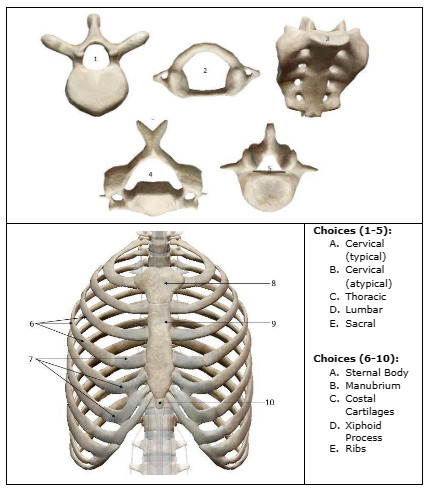
B. The Upper Limb
Identification. Identify the Carpal Bones. Write your answers on the answer table.

C. The Lower Limb
Identification. Identify the Tarsal Bones. Write your answers on the answer table.





Questions for Enrichment
Describe the structures that are common to most vertebrae
Most vertebrae share a common structural design, which can be described as follows: Body or Centrum which is the main mass of the vertebra, which is usually shaped like a cylindrical or triangular block, Neural arch which is a bony arch that projects posteriorly from the body of the vertebra to form a protective enclosure around the spinal cord. Spinous process is a bony projection that extends from the top of the neural arch which serves as an attachment point for muscles and ligaments, the Transverse processes include two bony projections that extend laterally from the neural arch, which also serve as attachment points for muscles and ligaments, next is the Articular processes which are two pairs of bony projections that articulate with adjacent vertebrae to form the facet joints, which allow for spinal mobility, the Intervertebral foramina has small openings between adjacent vertebrae, which allow for the passage of spinal nerves and blood vessels.
Name and give the number of vertebrae in each of the five regions
of the vertebral column. Describe the characteristics that distinguish the different regions of vertebrae.
The five regions of the vertebral column are:
1. Cervical region: The cervical region consists of the first seven vertebrae of the spinal column (C1-C7). These vertebrae are located in the neck region and are characterized by a small body size, a large vertebral foramen, and a bifid (split) spinous process on the posterior side.
2. Thoracic region: The thoracic region consists of 12 vertebrae (T1-T12) located in the upper back. These vertebrae are characterized by having costal facets, which are small depressions on the body of the vertebrae that articulate with the ribs. The spinous processes of the thoracic vertebrae are long and point downward.
3. Lumbar region: The lumbar region consists of five large vertebrae (L1-L5) located in the lower back. These vertebrae are characterized by having a large body size and a thick, short spinous process that projects posteriorly.
4. Sacral region: The sacral region consists of five fused vertebrae (S1-S5) that form the sacrum. The sacrum is located at the base of the spine, between the two hip bones. It is characterized by having a triangular shape and several foramina (openings) that allow for the passage of nerves and blood vessels.
5. Coccygeal region: The coccygeal region consists of four fused vertebrae that form the coccyx, also known as the tailbone. The coccyx is located at the base of the sacrum and is characterized by having a small, triangular shape.
The characteristics that distinguish the different regions of vertebrae are primarily related to their location and function. The cervical vertebrae are specialized to allow for movement of the head and neck, while the thoracic vertebrae provide attachment sites for the ribs and protect the organs in the chest cavity. The lumbar vertebrae are designed to support the weight of the upper body, and the sacral and coccygeal vertebrae provide attachment sites for muscles and ligaments in the pelvic region.
In addition, most vertebrae also have specialized structures or features that are unique to their particular region of the spine (cervical, thoracic, lumbar, sacral, or coccygeal).
For example, cervical vertebrae typically have transverse foramina that allow for the passage of vertebral arteries, while lumbar vertebrae tend to have larger bodies and thicker spinous processes to support weight-bearing.
What is the function of the thoracic cage? Distinguish among true, false, and floating ribs, and give the number of each type
The thoracic cage, or rib cage, is a bony structure that offers protection and support for the vital organs of the chest, such as the heart and lungs. It comprises 12 pairs of ribs, the sternum, and the thoracic vertebrae. The first 7 pairs of ribs are considered true ribs, as they directly attach to the sternum via their costal cartilage. The next 3 pairs of ribs are called false ribs, as they indirectly attach to the sternum via the cartilage of the 7th rib. Lastly, the last 2 pairs of ribs are referred to as floating ribs, as they do not attach to the sternum at all and only attach to the vertebrae in the back. The thoracic cavity and its internal organs are safeguarded by the true ribs, whereas the false and floating ribs provide supplementary support and flexibility to the chest. Altogether, the human thoracic cage consists of 12 ribs, among which 7 are true, 3 are false, and 2 are floating.
Which bones form the ankle joint? What bone forms the heel?
Three bones make up the ankle joint. First, the Tibia which is the stronger and larger of the two lower leg bones makes up the inner side of the ankle. The Fibula which is the smaller bone of the lower leg forms the outer part of the ankle. Connecting these two to the foot is the Talus, which is also known as the ankle bone. It is found at the lower part of the ankle joint and sits at the heel bone. This heel bone that forms the heel is called the Calcaneus which is also the largest bone of the foot.
Describe the articulation of the ribs with thoracic vertebrae
The costovertebral joint is formed by the ribs' posterior ends articulating with the thoracic vertebrae. The head and the tubercle of each rib are where it joins the thoracic vertebrae. The tubercle of the rib articulates with the transverse process of the thoracic vertebra above it, whereas the head of the rib articulates with the body of the vertebra of the same number. During physical exercise, the costovertebral joint, a synovial joint that permits minor movement between the ribs and the thoracic vertebrae, helps with breathing and chest wall movement. The ribcage is stabilized and supported by muscles and ligaments that support the joint.
If you were a dietician who had a young female patient with a family history of osteoporosis, what foods would you suggest she include in her diet? Why?
Since her family has a history of osteoporosis, I will advise her to take food rich in calcium, protein, and vitamin D such as oatmeal, canned sardines, dairy products, baked beans, meat, fish, soy, legumes, and nuts. Because taking foods rich in vitamin D, protein and calcium will prevent the weakening of the bones and will prevent her from developing the disease. Calcium, protein, and vitamin D are all essential nutrients for bone health. Calcium and protein help to strengthen bones, while vitamin D helps the body absorb calcium. Therefore, if she takes foods that are rich in these nutrients, her bones will be stronger and better able to resist the effects of osteoporosis.
References:
Arthritis Foundation
https://www.arthritis.org/health-wellness/about-arthritis/where-it-hurts/ankle-anatomy#:~:text=the%20tibia%2C%20the%20larger%20and,the%20calcaneus%2C%20or%20heel%20bone.
KenHub
https://www.kenhub.com/en/library/anatomy/foramina-and-fissures-of-the-skull
SportsMed
https://sportsmedalabama.com/contents/patient-education/foot-and-ankle/#:~:text=Calcaneus%3A%20the%20heel%20bone%20and,and%20fibula%20with%20the%20foot.
OpenStaxCollege
https://pressbooks-dev.oer.hawaii.edu/anatomyandphysiology/chapter/the-thoracic-cage/
Osmosis
https://www.osmosis.org/learn/Bones_of_the_vertebral_column
OpenStaxCollege
https://pressbooks-dev.oer.hawaii.edu/anatomyandphysiology/chapter/the-vertebral-column/
OpenStaxCollege
https://pressbooks-dev.oer.hawaii.edu/biology/chapter/joints-and-skeletal-movement/
SchoolBag
https://schoolbag.info/biology/anatomy/2.html
Contributions
Kaila Mallari (Illustrations C and Questions for Enrichment 4)
Jabez Mujar: (Illustrations A and Questions for Enrichment 2)
Pamela Masangcay: (Illustration A and Questions for Enrichment 1)
Mi-yein Mercado: (Illustration B and Question for Enrichment 6)
0 notes